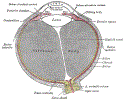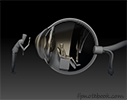Eye Anatomy, Limbus Corneae, Iris, Uvea, Conjunctiva, Aqueous Humor, Aqueous Outflow Angle
- See Also
- Images
- Globe
 Lewis (1918) Gray's Anatomy 20th ed (in public domain at Yahoo or BartleBy)
Lewis (1918) Gray's Anatomy 20th ed (in public domain at Yahoo or BartleBy) Lewis (1918) Gray's Anatomy 20th ed (in public domain at Yahoo or BartleBy)
Lewis (1918) Gray's Anatomy 20th ed (in public domain at Yahoo or BartleBy) Lewis (1918) Gray's Anatomy 20th ed (in public domain at Yahoo or BartleBy)
Lewis (1918) Gray's Anatomy 20th ed (in public domain at Yahoo or BartleBy) Lewis (1918) Gray's Anatomy 20th ed (in public domain at Yahoo or BartleBy)
Lewis (1918) Gray's Anatomy 20th ed (in public domain at Yahoo or BartleBy)
- Iris
 Lewis (1918) Gray's Anatomy 20th ed (in public domain at Yahoo or BartleBy)
Lewis (1918) Gray's Anatomy 20th ed (in public domain at Yahoo or BartleBy)
- Nerves
- Extraocular Motor
- Choroid
- Vessels
-
Retina
- See Retinal Anatomy
- Lacrimal and lids
- See Lacrimal Anatomy
- Lids
- See Lid Anatomy
- Miscellaneous
- Anatomy
- General
-
Eyelids
- Both lids contain a tarsal plate with Meibomian glands
- Lids join at medial and lateral canthi
-
Sclera
- See Sclera
- Thick, protective outer coat of the eye underlying the Conjunctiva
- Normally white (with possible bluish discoloration) and opaque
- Scleral inflammation is very painful, and associated with Vision Loss
- Episclera
- Limbus
- Iris
- Uvea
- Pupil
- Lens
- Fine, variable focus of light directed at the Retina
- Cataracts clous the lens, resulting in Decreased Visual Acuity
- Conjunctiva: Thin, vascular tissue
- Covers inner lid lining (palpebral Conjunctiva)
- Covers Sclera (bulbar Conjunctiva)
-
Cornea
- See Refractive Error
- See Cornea
- Transparent front refractive window of eye
- Macula and Fovea
- See Extraocular Movement
- Medial Range of Motion
- Medial Rectus (Cranial Nerve III)
- Lateral Range of Motion
- Lateral Rectus (Cranial Nerve VI)
- Upward Range of Motion
- Superior Rectus (Cranial Nerve III)
- Inferior Oblique (Cranial Nerve III)
- Downward Range of Motion
- Inferior Rectus (Cranial Nerve III)
- Superior Oblique (Cranial Nerve IV)
- Anatomy
- Chambers
- Anterior Chamber
- Between Cornea and iris
- Contains Aqueous Humor
- Posterior Chamber
- Between iris and lens zonulae (very small space)
- Also contains Aqueous Humor
- Ciliary body
- Produces Aqueous Humor
- Contains ciliary Muscle ring
- Suspends lens by fine ligamentous zonule fibers (zonulae)
- Ciliary Muscle Contraction narrows ring diameter, relaxing tension on lens
- Lens assumes and thicker, rounder shape, resulting in Visual Accommodation (near focus)
- Contrast with iris dilator (Mydriasis) and iris constrictor (Miosis) Muscles
- Aqueous Humor
- Aqueous Humor
- Clear fluid that fills anterior and posterior chamber
- Produced by ciliary body
- Passes through pupil
- Drains via trabecular meshwork (at outflow angle)
- Aqueous Outflow Angle
- Aqueous Humor
- Vitreous Cavity
- Large space (4.5 cc) between lens and Retina
- Contains transparent thick gel (vitreous humor)
- Additional vitreous humor is not produced after the eye develops
- Contrast with Aqueous Humor that is produced throughout the eye's lifetime
- Anatomy
- Vascular
